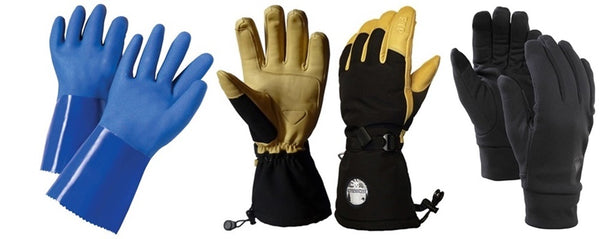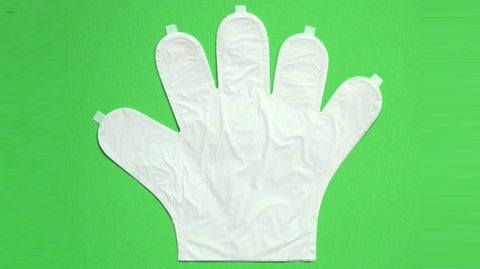Breathable ski gloves?
Breathability in ski gloves is perhaps the most important trait. It determines the glove's versatility in regards to temperature and general weather conditions. But a balance needs to be struck between breathability and waterproofness. Forget the hype, no material is highly breathable and highly water-proof in the long-term AT THE SAME TIME. A glove that is 100% breathable has zero water-resistance. And a glove with 100% waterproofing (rubber) has zero breathability.

This conundrum leads to a frustrating testing protocol for a designer. You have to make a value judgement on the balance between the two competing variables. Since rubber gloves (100% water-proof) are totally impractical, we at Free the Powder Gloves started our R & D with various membrane inserts, which are synthetic gloves placed between the liner and the shell. (They are marketed as "water-proof"). I wanted to find a waterproof membrane that was, in fact, as waterproof and breathable as advertised. It took more than 100 days of testing with a membrane glove on one hand and a non-membrane glove on the other to come to terms with the truth: one does not currently exist, as advertised. I had various levels of moisture on my membrane-gloved hand most of the time from sweat build-up, which led to a constant cold-warm-cold cycle. Hand starts cold, gets warm, sweats, gets cold again and stays cold. The temperature and environmental factors did not matter.

On the very wettest days of field-testing my “waterproof” membrane gloves got saturated nearly as fast as my non-membraned gloves. The benefits don't last long. Water seems to always find a way in, especially when you need to remove your gloves. The real difference became apparent when the rain stopped: the ultra-breathable glove with no membrane dried much faster, while the membraned glove remained wet until it was finally placed on a heat source (at home).
We ultimately abandoned the current “waterproof” membranes, having come to the conclusion that maximum breathability gives a glove its widest range of climatic versatility and comfort. Waterproof membranes are really just a "plastic-bag-on-your-hand" strategy of waterproofing with limited practical use. A better approach to "water-proofing" balances the competing problems of external moisture penetration (rain/wet-snow) and internal moisture production (sweat). This means proper tanning and treatment of the leather, proper DWR (durable water repellent) treatment of the nylon shell, use of premium thread between sections of the gloves, proper closure system at the wrist, and most importantly, highest quality skill in stitching the seams.
Someday, when we find a "waterproof-breathable" membrane insert that works to our satisfaction, we will offer them in our gloves. We are testing some new technology now and it is promising. Stay tuned.
Here are the design variables that make Free the Powder Gloves so breathable:
- We use natural cowhide leather that is softer and more breathable than the more rigid leather that is used in most ski gloves.
- We do not use a petroleum-based sealant on our leather, but a fatliquor immersion that stops water from soaking through, while maintaining its breathability. When you see a leather palm on a ski glove that has no level of moisture at all on the outer surface, you will know that you are looking at leather whose pores have been completely sealed, rendering the leather un-breathable. That's bad. Also, petroleum-based sealant degrades the leather, shortening its usable life.
- The liner: we use Breathefil™ insulation, Free the Powder's proprietary blend of synthetic microfibers that maximize breathability. Following this strategy allows use to use less insulation to overcome the sweat moisture problem associated with waterproof membranes. 200 grams of highly breathable insulation is excellent for a wide range of temperatures.
- We use 4-way stretch softshell nylon instead of the more commonly used hardshell nylon. It’s nearly as tough and much more breathable.
For a large percentage of our customers, a glove designed to be as breathable as possible (for a cold weather, heavily insulated glove) has completely changed their skiing experience for the better. It certainly has for me. That's why I started the company.
Learn more about ski glove design:

